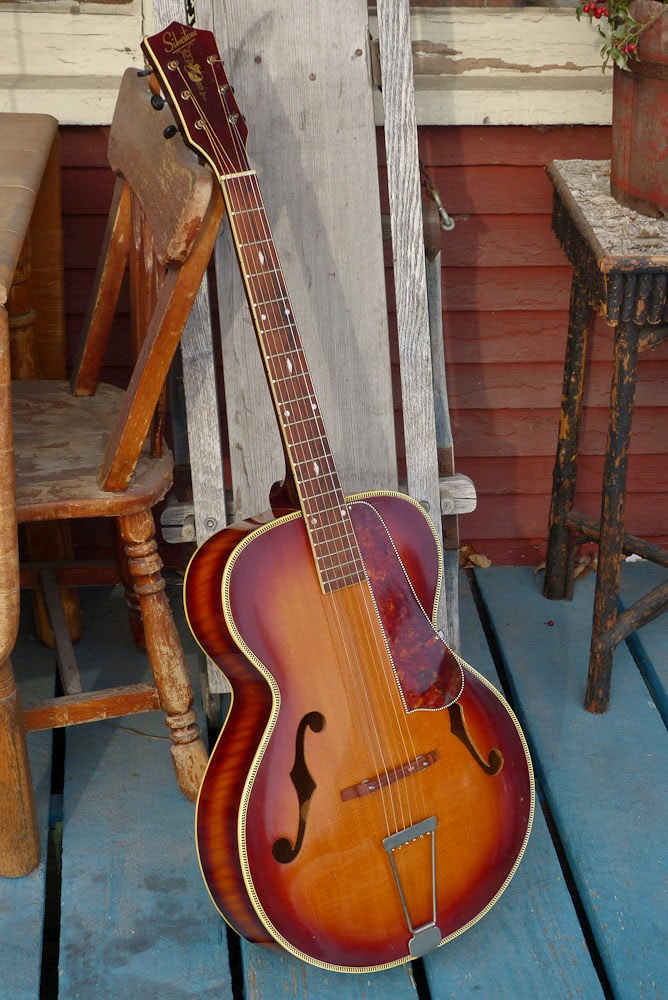1941 Kay-made Silvertone Crest Archtop Guitar
This guitar has come in for consignment and only needed minor tweaking to get it up to spec. It's a very clean Kay-made archtop with their usual dimensions (1 11/16" nut, U-shaped baseball-batty neck, 15 1/4" lower bout, and longish 25 3/4" scale length). This would've been sold in the Sears catalog with the Silvertone name attached and the Kluson tuner types used dates this to 1941, pretty much, as the units weren't made once we were at war.
My work included rebuttoning and lubing the original tuners for reinstallation as well as intonating the bridge for the B string, rehanging the tailpiece slightly "bass" for better string pull, and giving the girl a good cleaning and setup. It plays spot-on with 3/32" bass and 1/16" treble action at the 12th fret and is strung with what feels like a set of 12s. At 25 3/4" the scale puts a lot of tension on these and so this has a gutsy, punchy sound that cuts right through the mix. Also, atypically for a Kay build, there's a lot of creamy, tight bass to the sound. This makes it ideal for crunchy 3-note jazz or big band comping work. The high end is clear, defined and snappy, too.
I love the cherry sunburst finish... especially with the checker-ish purfling, cream binding (top and back), and checker-edged tortoise-celluloid pickguard. Add to that the headstock and fretboard binding and you've got a pretty upscale look.
The logo is fantastic!
All hardware is original on this rig except for my addition of black tuner buttons to replace the damaged original cream ones. The nut is bone.
The fretboard is Brazilian rosewood and radiused with pearl dots and diamonds. The frets are clearly original, medium in size, and untouched. It's like this was played lightly for a month or so and then put back in the case. Who knows why? Perhaps someone "joined up" shortly after buying this guitar.
When strung up with 12s at pitch the neck deflects a hair above 1/64" -- which is absolutely normal for just about any guitar. If it were mine, like on all long-scale Kays, I'd prefer to use a hybrid set of strings with the wounds from a 50w-11 set and the trebles from a 12s set. That gives a slinkier feel on the bass side.
Don't you love all that contrast?
The thin (nitro) finish is in excellent shape with only minor pickwear here and there and a few small scratches scattered about. This could be an "as new" guitar hanging in a guitar store, if you didn't know it was 70+ years old.
The original adjustable bridge is made from Brazilian rosewood as well.
The top of this guitar is solid spruce while the back and sides are laminate flamed maple. I'm guessing that the neck is poplar or maple but it does have "faux flame" painted on its back.
Aren't these covered tuners awesome? Below the plates are standard 1940s scalloped baseplate Klusons with the non-adjustable shaft join (no screw to attach shaft to gear).
I'm wondering if someone reset the neck on this guitar some time ago because it's perfectly stable and has a good back-angle. In addition the fretboard extension just ever so slightly dips down towards the body which is usually a sign of a neck reset at some point.
Here's the back of that neck.
The flamed maple used on the back and sides is sure to catch some attention awaiting use on a stand during a show.
Rosewood endstrip with original oversized strap button.
An original chip case comes with the guitar and would be useful for light use or storage.
The owner printed out a page from the 1941 Sears catalog which clearly shows this same guitar model.



























Comments
Does this guitar have a steel reinforced neck?
Best, Ian.